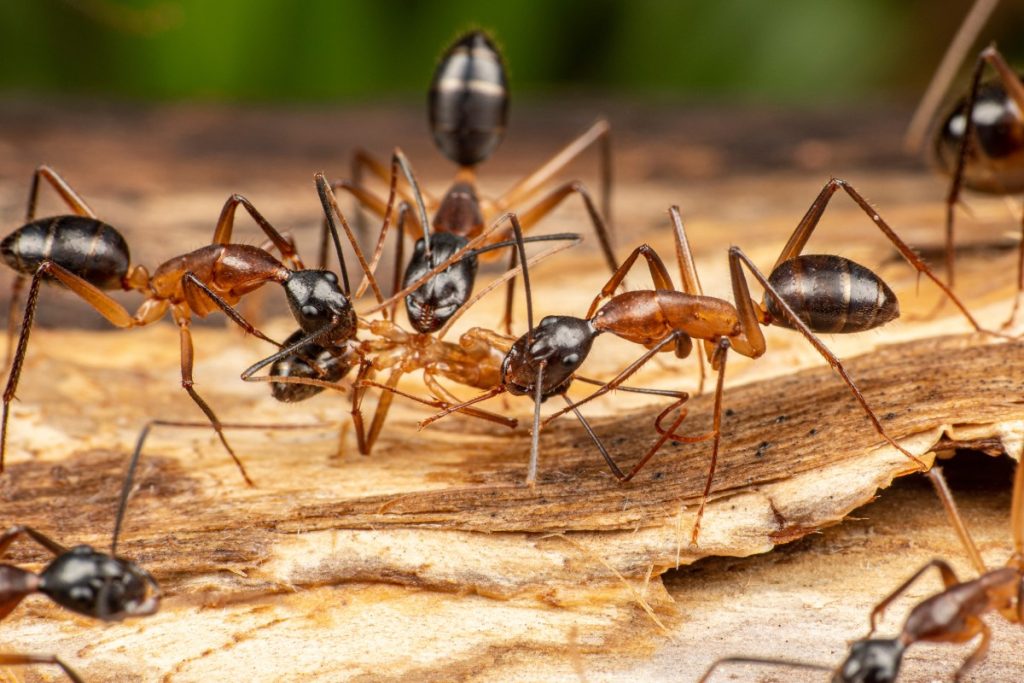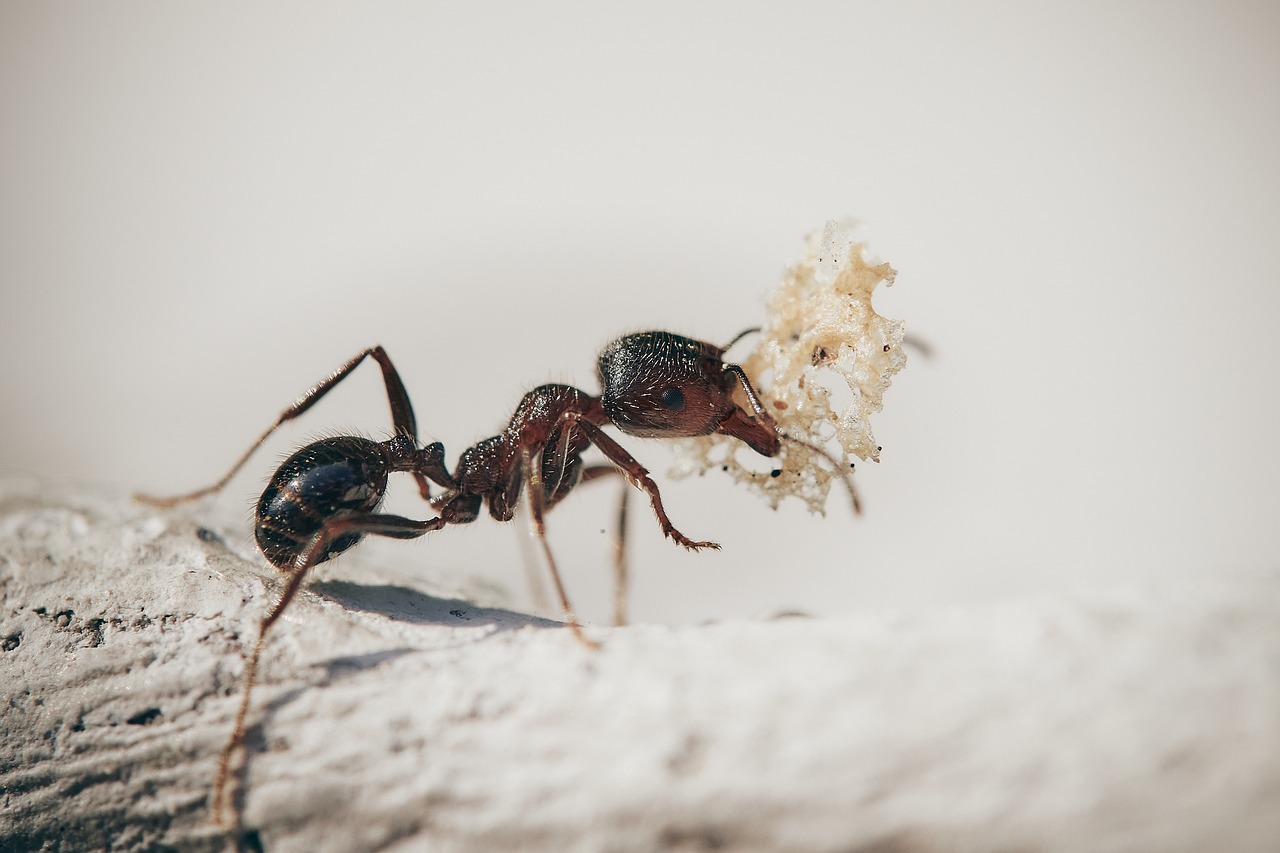Acrobat ants
Scientific name: Crematogaster
Description: Light red to brown ants known for raising their abdomen over their thorax and head when agitated.
Habitat: Widely distributed throughout the United States.
Pest Potential: Can enter homes in search of food and moisture.
Allegheny Mound Ants
Scientific name: Formica exsectoides
Description: Renowned for constructing large mounds. Colors range from reddish to dark brown or black.
Habitat: Primarily in fields and forests in eastern North America.
Pest Potential: Can damage ornamental plants.
Argentine Ants
Scientinfic name: Linepithema humile
Description: Small, light to dark brown ants known for forming vast supercolonies.
Habitat: Originally from Argentina, but now found globally.
Pest Potential: Displacement of native ant species, infestations in homes.
Bigheaded Ants
Scientific name: Pheidole
Description: Named for the disproportionately large heads which are often two to three times larger than the rest of the body. Colors range from reddish-brown to dark brown.
Habitat: Worldwide distribution.
Pest Potential: Common household pests.
Army Ants
Description: Aggressive foraging behavior, with species varying in size and color.
Habitat: Global distribution.
Pest Potential: Not known for infesting homes but can be a nuisance when in large numbers.
Carpenter Ants
Scientific name: Camponotus
Description: Large ants that can cause structural damage by excavating wood to form nests. Colors are predominantly black but may have reddish or yellowish tints.
Habitat: Found worldwide.
Pest Potential: Wood damage in structures.
Citronella Ants
Scientific name: Lasius
Description: Named for the lemon or citronella scent they release when crushed. Typically yellow to light brown.
Habitat: Damp, wooded regions.
Pest Potential: Not generally a household pest but can be a nuisance if found indoors.
Cow Killer Ants
Scientific name: Dasymutilla occidentalis
Description: Actually a wingless wasp with a very painful sting. Also referred to as Velvet Ants because of their dense, often bright red or gold hair.
Habitat: Found in various environments, but primarily grassy or sandy areas.
Pest Potential: Their sting is painful, but they're not common household pests.
Elongate Mexican Twig Ants
Scientific name: Pseudomyrmex gracilis
Description: Slender ants, colors range from orange-brown to dark brown.
Habitat: Thorny vegetation, native to Mexico but now also present in the southern U.S.
Pest Potential: Not significant, but may enter homes occasionally.
Field Ants
Scientific name: Formica
Description: Variable colors including black, brown, red, and bicolor combinations. Known for constructing mounds in open fields.
Habitat: Open fields.
Pest Potential: Can bite or sting if disturbed.
Crazy Ants
Description: Known for erratic and rapid movements. Species may vary in appearance.
Habitat: Predominantly in southern U.S.
Pest Potential: Significant pest in homes.
Fire Ants
Scientific name: Solenopsis
Description: Aggressive ants with a painful sting, reddish-brown in color.
Habitat: Often found in open areas constructing mounds.
Pest Potential: Destroys crops
Ghost Ants
Scientific name: Tapinoma melanocephalum
Description: Tiny ants with a dark head and thorax. The abdomen and legs are translucent, giving them a ghostly appearance.
Habitat: Prefer warmer climates, but can be found indoors worldwide.
Pest Potential: Nuisance in homes, attracted to sweet foods.
Grease Ants
Scientific name: Solenopsis molesta
Description: Very tiny ants that are attracted to high-protein foods.
Habitat: Global distribution.
Pest Potential: Pests in homes and eateries.
Harvester Ants
Scientific name: Pogonomyrmex
Description: Typically red, known for collecting seeds to eat later.
Habitat: Arid regions.
Pest Potential: Their sting is excruciating, but they're not typically household pests.
Leafcutter Ants
Description: Known for cutting leaves to cultivate fungus gardens inside their colonies. Brown or reddish in color.
Habitat: Predominantly in South and Central America.
Pest Potential: Not typical household pests but can be agricultural pests.
Moisture Ants
Description: Range from yellow to dark brown, prefer moist environments.
Habitat: Damp regions and wood.
Pest Potential: Structural damage by nesting in damp wood.
Odorous Ants
Scientific name: Tapinoma sessile
Description: Small, dark ants emitting a rotten coconut-like odor when crushed.
Habitat: Often trail along sidewalks, baseboards, and walls looking for food.
Pest Potential: Devour sugary foods and dairy products in food storage areas.
Pavement Ants
Scientific name: Tetramorium caespitum
Description: Brown to black ants that nest in or under pavement cracks.
Habitat: Often trail driveways, sidewalks, and other concrete sections
Pest Potential: Can infest homes and gardens.
Pharaoh Ants
Scientific name: Monomorium pharaonis
Description: Tiny ants, light yellow to red in color.
Habitat: Found globally, especially in warm regions.
Pest Potential: Major indoor nuisance, can spread pathogens.
Pyramid Ants
Scientific name: Dorymyrmex
Description: Typically reddish-brown or black with a pyramid-like projection on the thorax.
Habitat: Dry, sandy areas, often in the southern U.S.
Pest Potential: Not significant.
Queen Ants
Description: Reproductive females responsible for egg laying in a colony. Larger than worker ants.
Habitat: Found in virtually all ant colonies.
Pest Potential: Not typically a direct pest, but essential for colony proliferation.
Rogers Ants
Scientific name: Dorymyrmex bicolor
Description: A species of pyramid ants found mainly in the southwestern U.S.
Habitat: Dry regions.
Pest Potential: Not significant.
Rover Ants
Scientific name: Brachymyrmex
Description: Rover ants are small ants, ranging from pale yellow to dark brown, often mistaken for pharaoh ants. They are attracted to various food sources, including sweets.
Habitat: Adaptable and may invade homes, searching for food and moisture.
Pest Potential: Can be nuisance pests indoors when they reach your food storage.
Honey Ants
Scientific name: Myrmecocystus
Description: Honey ants have specialized workers, repletes, that store food in their abdomens for the colony. These ants serve as living food reservoirs.
Habitat: Often found in arid regions where resources may be scarce.
Importance: Vital for colony survival during periods of scarcity.
Sugar Ants
Description: "Sugar ants" encompass several species attracted to sugary foods. Camponotus consobrinus is one such species drawn to sweets.
Habitat: Found in various environments, particularly near human settlements.
Pest Potential: Can invade homes for sugary foods.
Thief Ants
Scientific name: Solenopsis molesta
Description: Tiny, yellow to brown ants known for their parasitic behavior, stealing food from other ant colonies.
Habitat: Found throughout the United States, often near other ant nests.
Pest Potential: Not major pests, but can disrupt other ant colonies.
White-Footed Ants
Scientific name: Technomyrmex difficilis
Description: Small, dark ants with whitish leg tips. They form large colonies with multiple queens.
Habitat: Primarily in subtropical climates.
Pest Potential: Nuisance pests that forage in kitchens, bathrooms, and building exteriors.
Winged Ants
Description: Winged ants are the reproductive males and females of colonies. They have pale wings.
Habitat: Found within their colonies.
Pest Potential: Can become a nuisance if they infest your property.
Wood Ants
Scientific name: Formica
Description: Wood ants are known for mound-building behavior and preference for wooded habitats. They are found mainly in Europe and Asia.
Habitat: Thrive in wooded areas, constructing mounds using twigs and leaves.
High Noon Ant
Scientific name: Forelius pruinosus
Description: An omnivorous ant species with a preference for live and dead insects, and honeydew produced by hemipteran plant pests. These ants are distinctive for their aggressiveness, and while they do not possess a sting, they are known to bite when disturbed.
Habitat: They often nest outdoors in both natural and human-disturbed areas. However, they are also known to forage within homes and buildings, and in some instances, might even choose to nest inside these structures.
Pest Potential: High noon ants pose a significant nuisance, especially as a household pest in the southern regions of the USA. Their aggressive nature and tendency to bite make them less than ideal house guests, and their adaptability means they can be found in a variety of environments, from natural settings to human-disturbed areas.

